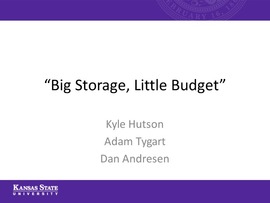| dc.contributor.author | Hutson, Kyle | |
| dc.contributor.author | Tygart, Adam | |
| dc.contributor.author | Andresen, Dan | |
| dc.date.accessioned | 2015-09-29T21:29:53Z | |
| dc.date.available | 2015-09-29T21:29:53Z | |
| dc.date.issued | 2015-09-23 | |
| dc.identifier.uri | https://hdl.handle.net/11244/19268 | |
| dc.description | Daniel Andresen, Ph.D. is an associate professor of Computing & Information Sciences at Kansas State University and Director of the Institute for Computational Research. His research includes embedded and distributed computing, biomedical systems, and high performance scientific computing. Dr. Andresen coordinates the activities of the K-State research computing cluster, Beocat, and advises the local chapter of the Association for Computing Machinery (ACM). He is a National Science Foundation CAREER award winner, and has been granted research funding from the NSF, the Defense Advanced Research Projects Agency (DARPA), and industry. He is a member of the Association for Computing Machinery, the IEEE Computer Society, the Electronic Frontier Foundation, and the American Society for Engineering Education.
____________________________________________________________________________________________
Kyle Hutson has been involved with Linux system administration since 1994. He received his bachelor's degree from Kansas State University in computer engineering in 1995. He has worked in non-profit, public sector, and public sector IT services, including several years as a small business IT consultant. Kyle joined Kansas State University's HPC team in 2012.
____________________________________________________________________________________________
Adam Tygart has been an HPC system administrator since 2008. He has been using Linux since high school. Beocat, Kansas State University's Gentoo-based HPC cluster, was implemented in its current form by Adam while still an undergraduate.
____________________________________________________________________________________________
Presented at the 2015 Oklahoma Supercomputing Symposium
at the University of Oklahoma
Wednesday September 23 2015, 8:00am-5:00pm
Thurman J. White Forum Building, 1704 Asp Ave., Norman OK 73072 | en_US |
| dc.description.abstract | Kansas State University's HPC cluster was running out of storage space last year. Vendors of traditional HPC storage solutions were either too expensive to be feasible or too little capacity to be of long-term use. The system that ended up providing the best storage capacity for the available budget was Ceph, an open-source project that provides storage striped across many commodity servers. This session is a case study of the pros and cons of our implementation of a 1.5 PB Ceph-based storage cluster, discussing the history of network-based filesystems, including why our previous Gluster-based was no longer suitable. Questions and discussion are encouraged. | en_US |
| dc.description.sponsorship | University of Oklahoma / The University of Oklahoma Department of Information Technology / The University of Oklahoma Supercomputing Center for Education and Research / Kansas State University | en_US |
| dc.language | en_US | en_US |
| dc.subject | Computer Science. | en_US |
| dc.subject | Supercomputing | |
| dc.title | Big Storage, Little Budget | en_US |
| dc.type | Presentation | en_US |
| dc.description.peerreview | No | en_US |
| ou.group | Oklahoma Supercomputing::Oklahoma Supercomputing Symposium::2015 | en_US |
| shareok.orcid | 0000-0003-2345-6695 | |
